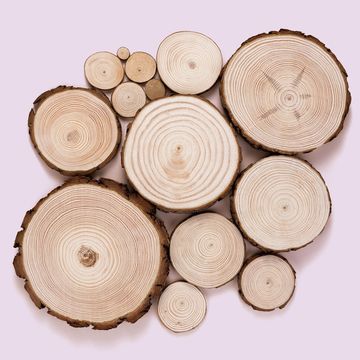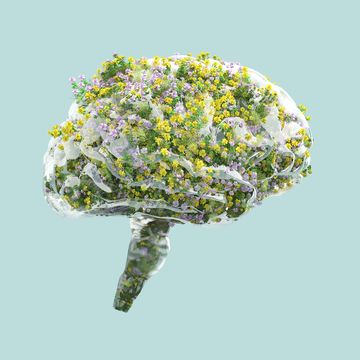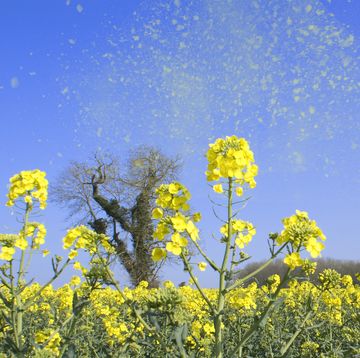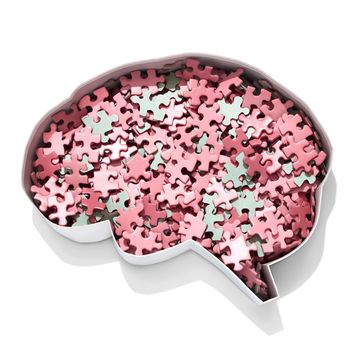If you’re one of the 50 million (!) people in the U.S. who suffer from allergies, you might think you’ve suffered enough to know what’s what when it comes to symptoms, triggers, and treatments. But there are some surprisingly pervasive assumptions about allergies, and even chronic snifflers and careful pollen-monitors might be surprised to learn the truth. Here are five key facts about allergies, which could help you manage your symptoms, feel better, and enjoy the whole year more.
Myth #1: Allergies disappear during the winter.
Not if you have indoor allergies—think dust mites, pet dander, and mold—in which case time indoors and less circulation of fresh air can mean worse symptoms, says Carla Ward, M.D., an allergist and immunologist with the Institute for Asthma & Allergy. Dusty holiday decorations and Christmas trees that may host mold can be culprits, adds David Shulan, M.D., an allergist and immunologist in Boynton Beach, FL. (Pine scent may also cause an allergic reaction in some people; for them, a fake tree is better.) In any case, vacuuming, dusting, and using mattress and pillow protectors are your best bets.
Myth #2: By the time you’re an adult, you’ll know if you have allergies.
Not necessarily. Though most pop up during childhood, allergies can strike at any age—particularly seasonal ones, says Dr. Ward. Allergies happen when your immune system mistakenly identifies a substance such as pollen or dust mites as harmful and then it attacks, releasing compounds that can affect your sinuses, eyes, airways, skin, and digestive system. You may notice it the first time you have contact with a substance or you may react only when you’ve been repeatedly exposed to it or if your immune system is weak. “It’s not uncommon to develop allergies one or two seasons after moving, with exposure to new trees, grasses, or weeds,” says Joshua Davidson, M.D., an allergist and immunologist in Redondo Beach, CA. Food allergies may also arise in adults—one large study found that nearly half of those with such allergies developed them in adulthood. Talk to a doc if your “cold” lingers or if you notice hives, mouth swelling or tingling, abdominal pain, or wheezing within two hours of eating—an allergist can help figure out what’s causing it.
Myth #3: Eating local honey can reduce hay fever symptoms.
Theoretically yes—in practice, no, because the bees probably aren’t visiting the plants that could help you. The idea is that by eating local honey, you’re exposing yourself to local pollen, which your body might get used to over time and stop reacting to—the same theory that explains how allergy shots work. But honeybees get most of their pollen from flowering plants, not the trees, grasses, and weeds that cause most hay fever. And the amount of pollen in a jar of honey can vary wildly, which makes it all but impossible to slowly build up a tolerance with a controlled dose, Dr. Davidson says. Meanwhile, climate change may be worsening allergy symptoms, University of Maryland research suggests. Start with lifestyle tweaks such as staying indoors when pollen counts are high and using vacuums and air purifiers with HEPA filtration. If that doesn’t help enough, it’s time to dial the doc.
Myth #4: You should take allergy meds only as needed.
Some allergy meds are better if you take them before you need them. You should give epinephrine when someone has an anaphylactic reaction, and antihistamines can suppress occasional allergy symptoms in as little as an hour. But for predictable seasonal allergies, taking the meds before you feel symptoms will dial down your reaction, lessening or even eliminating your symptoms. That’s why many doctors recommend a daily oral antihistamine, such as Claritin or Zyrtec, to patients with seasonal allergies, says Dr. Shulan. And a nasal steroid spray should be started before allergy season hits, “because it can take two weeks to reach full effectiveness,” he says.
Myth #5: You shouldn’t buy flowers for someone with allergies.
You’re not bringing them a ragweed bouquet, are you? Then you’re probably okay. The most common seasonal allergens are grasses (which ragweed grows among). Most decorative flowering plants don’t make much pollen, or else they produce heavy pollen that doesn’t travel via the wind, Dr. Davidson says. Dr. Ward tells her patients to go for varieties that aren’t likely to shed pollen (like camellias, roses, and lilies) and steer clear of daisies, sunflowers, and chamomile. And while a houseplant may seem like a thoughtful swap for a bouquet of cut flowers, keep in mind that potted plants can attract dust and even mold if they are overwatered. If your friend has indoor or outdoor allergies, it’s best to stick to a botanical present she can enjoy and then toss.













